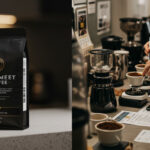
The Historical Background of Coffee: A Timeless Tradition
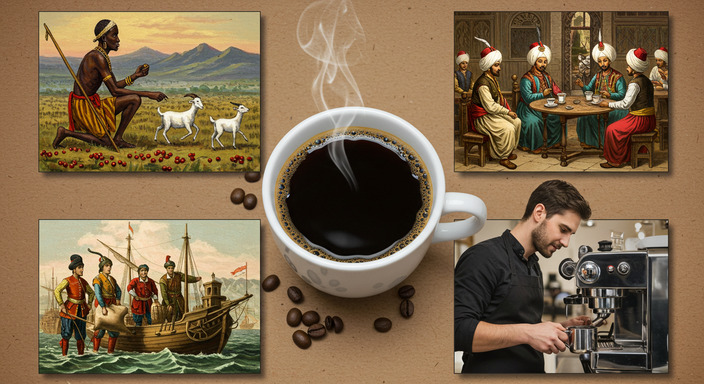
Table of Contents
ToggleThe Origins of Coffee
The Legend of Kaldi and the Discovery of Coffee Beans
In the lush highlands of Ethiopia, a timeless tale unfolds—the legend of Kaldi, a goat herder whose curiosity changed the world. As the story goes, Kaldi noticed his goats dancing with unusual energy after nibbling on bright red berries from a peculiar shrub. Intrigued, he tasted the berries himself, feeling a surge of vitality. This discovery, shrouded in myth, is believed to mark the first encounter with coffee. Though the tale of Kaldi may be more folklore than fact, it beautifully captures the enchantment surrounding coffee’s origins.
Early Cultivation in Ethiopia and Yemen
From these mystical beginnings, coffee found its first home in Ethiopia, where it was cultivated and cherished by local communities. The beans were often consumed as a stimulating paste or brewed into a rudimentary drink, forming an integral part of social and spiritual rituals. By the 15th century, coffee had crossed the Red Sea to Yemen, where it became a staple in Sufi monasteries. Monks credited the brew with helping them stay awake during long hours of prayer, cementing its role as a sacred and practical elixir.
The Spread of Coffee to the Arabian Peninsula
As Yemen embraced coffee, the drink began its journey across the Arabian Peninsula. The port city of Mocha became a bustling hub for coffee trade, and the beverage’s popularity soared. Coffee houses, known as qahveh khaneh, emerged as vibrant social spaces where people gathered to discuss politics, exchange ideas, and enjoy the rich, aromatic brew. By the 16th century, coffee had woven itself into the cultural fabric of the region, setting the stage for its eventual global spread. It was here, in these early coffee houses, that the tradition of sharing a cup of coffee as a symbol of connection truly began.
Coffee’s Journey to the World
The Role of Trade Routes in Spreading Coffee
The story of coffee’s global journey begins in the lush highlands of Ethiopia, where legend says a goat herder first discovered the energizing effects of coffee beans. From there, coffee traveled along ancient trade routes, carried by merchants and pilgrims who shared its secrets across the Arabian Peninsula. By the 15th century, coffee had become a staple in the Islamic world, enjoyed in bustling markets and quiet homes alike. The port city of Mocha in Yemen became a hub for coffee trade, its name forever linked to the rich, chocolatey brew it exported. These trade routes were the veins that carried coffee’s lifeblood to the far corners of the world, transforming it from a regional treasure to a global phenomenon.
The Rise of Coffeehouses in Europe
As coffee made its way to Europe in the 17th century, it sparked a cultural revolution. Coffeehouses, often called “penny universities,” became gathering places for thinkers, writers, and merchants. In cities like London, Paris, and Vienna, these establishments buzzed with conversation and ideas. Coffeehouses were more than just places to drink—they were centers of innovation and debate. Here, the simple act of sipping coffee became a ritual of connection and exchange. By the 18th century, coffee had firmly rooted itself in European daily life, offering a warm, caffeinated alternative to alcohol and shaping the social fabric of the continent.
Coffee’s Introduction to the Americas
Coffee’s journey continued across the Atlantic, where it found fertile ground in the Americas. The first coffee plants arrived in the Caribbean in the early 18th century, thriving in the tropical climates of places like Martinique and Haiti. From there, coffee cultivation spread to Central and South America, where it became a cornerstone of economies and cultures. In the United States, coffee’s popularity soared during the Revolutionary War, when it replaced tea as the patriotic drink of choice. By the 19th century, coffee was deeply woven into the fabric of American life, from the bustling streets of New York to the quiet kitchens of rural homesteads. Its introduction to the Americas marked the beginning of a love affair that endures to this day.
Coffee in American Culture
The Boston Tea Party and the Rise of Coffee in the U.S.
In the annals of American history, few events have had as profound an impact on the nation’s beverage preferences as the Boston Tea Party of 1773. This act of defiance against British taxation not only symbolized the fight for independence but also marked a turning point in American drinking habits. As tea became a symbol of British oppression, coffee emerged as the patriotic alternative. By the time the Revolutionary War ended, coffee had firmly established itself as the preferred drink of a newly independent nation. Its bold flavor and energizing properties mirrored the spirit of resilience and determination that defined the American people.
The Evolution of Diner-Style Drip Coffee
As America grew, so did its love affair with coffee. By the early 20th century, the rise of diners and roadside cafes brought with it the iconic diner-style drip coffee. Brewed in large, stainless steel pots and served in thick, white mugs, this no-frills coffee became a staple of American life. Its simplicity and accessibility made it a favorite among workers, travelers, and families alike. The diner experience—complete with the comforting aroma of freshly brewed coffee and the clinking of spoons against ceramic—remains a cherished memory for many, a testament to the enduring appeal of this humble brew.
Coffee’s Role in Social and Cultural Gatherings
Beyond its role as a morning pick-me-up, coffee has long been a cornerstone of American social and cultural life. From kitchen table conversations to community meetings, coffee has a unique ability to bring people together. In the 1950s and 60s, coffeehouses became hubs for artists, writers, and activists, fostering creativity and intellectual exchange. Today, coffee continues to play a vital role in gatherings, whether it’s a casual catch-up with friends or a formal business meeting. Its presence is a reminder of the simple yet profound ways in which coffee enriches our lives and connects us to one another.
The Evolution of Coffee Brewing
Traditional Brewing Methods Through the Ages
For centuries, coffee brewing has been a ritual steeped in tradition and simplicity. From the ancient Ethiopian practice of boiling coffee cherries to the Turkish ibrik, which introduced finely ground coffee to boiling water, these methods laid the foundation for the coffee culture we cherish today. The French press, invented in the 19th century, brought a new level of control and richness to the brewing process, allowing coffee lovers to savor the full-bodied flavors of their beans. These timeless techniques remind us that coffee is more than a beverage—it’s a connection to history and heritage.
The Invention of the Drip Coffee Maker
In the early 20th century, the invention of the drip coffee maker revolutionized how Americans brewed their daily cup. Melitta Bentz’s ingenious use of a paper filter in 1908 paved the way for cleaner, smoother coffee. By the 1970s, automatic drip machines became a staple in American households, offering convenience without sacrificing flavor. This innovation not only made coffee more accessible but also cemented its role as a comforting morning ritual for millions. The drip coffee maker remains a symbol of simplicity and reliability, embodying the essence of classic American coffee culture.
The Resurgence of Manual Brewing Techniques
In recent years, there has been a renewed appreciation for manual brewing methods, as coffee enthusiasts seek to reconnect with the art of brewing. Techniques like the pour-over, AeroPress, and cold brew have gained popularity, offering a hands-on approach that highlights the nuances of each coffee bean. This resurgence isn’t just about flavor—it’s about slowing down and savoring the process. As we return to these traditional methods, we rediscover the joy of crafting a perfect cup, one that reflects both skill and passion.
Coffee’s Role in Daily Life
The Morning Ritual of Coffee
For many, the day does not truly begin until the first sip of coffee touches their lips. This morning ritual is more than just a habit; it’s a cherished moment of quiet before the chaos of the day unfolds. The aroma of freshly brewed coffee fills the kitchen, awakening the senses and setting the tone for what lies ahead. Whether it’s a quick cup of drip coffee or a carefully crafted pour-over, this daily act is a testament to the timeless appeal of coffee in our lives.
In diners across America, the sound of coffee pots hissing and cups clinking is a familiar soundtrack to breakfast. The simple pleasure of holding a warm mug, watching the steam rise, and taking that first sip connects us to a tradition that spans generations. It’s a ritual that transcends time, uniting us in a shared experience of comfort and anticipation.
Coffee as a Symbol of Hospitality
Coffee has long been a symbol of warmth and welcome. In homes and social gatherings, the phrase “Would you like a cup of coffee?” is more than an offer—it’s an invitation to pause, connect, and share a moment. This gesture of hospitality is deeply rooted in cultural traditions around the world. From the aromatic Turkish coffee served in ornate cups to the Italian espresso enjoyed at a bustling café, coffee is a universal language of kindness and connection.
In America, the tradition of offering coffee to guests is a hallmark of generosity. Whether it’s a casual visit or a formal event, the act of brewing and serving coffee is a way to say, “You are welcome here.” It’s a simple yet powerful way to create bonds and foster a sense of community.
The Emotional Connection to Coffee Traditions
Coffee is more than a beverage—it’s a vessel for memories and emotions. Many of us associate the taste and smell of coffee with moments of joy, reflection, and togetherness. For some, it’s the memory of sitting at the kitchen table with a grandparent, sipping coffee and listening to stories. For others, it’s the comforting routine of a morning brew shared with a loved one or a quiet moment of solitude in a favorite chair.
These traditions are passed down through families and cultures, creating a sense of continuity and belonging. The rituals surrounding coffee—whether it’s grinding beans by hand, using a cherished French press, or visiting a favorite local café—carry with them a deep emotional resonance. They remind us of who we are, where we’ve come from, and the simple pleasures that make life meaningful.
- The sound of a coffee grinder on a sleepy morning.
- The way the first sip of coffee melts away the fog of sleep.
- The laughter shared over a pot of coffee with friends.
Iconic Coffee Moments in History
Coffee’s Influence on Literature and Art
Throughout history, coffee has been a muse for writers, poets, and artists alike. Its aroma and warmth have inspired countless works of art and literature, becoming a symbol of creativity and contemplation. Legendary authors like Honoré de Balzac and Voltaire were known to fuel their writing marathons with copious amounts of coffee. Balzac once famously said, “Coffee is a great power in my life; I have observed its effects on an epic scale.” In the world of art, coffeehouses served as meeting places for thinkers and creators, fostering the exchange of ideas that shaped movements like the Enlightenment and Romanticism.
Even in modern times, coffee continues to be a recurring theme in literature and art. From the cozy coffee shops in Gilmore Girls to the introspective moments in Haruki Murakami’s novels, coffee remains a beloved symbol of comfort and introspection.
Famous Historical Figures and Their Love for Coffee
Some of history’s most influential figures were avid coffee enthusiasts. Ludwig van Beethoven meticulously counted 60 beans for his perfect cup every morning, while Benjamin Franklin frequented London coffeehouses to discuss politics and philosophy. Even Theodore Roosevelt reportedly drank a gallon of coffee daily, claiming it gave him the energy to govern the nation.
In the 18th century, coffeehouses became hubs for revolutionary ideas. The Green Dragon Tavern in Boston, for instance, was a meeting spot for the Sons of Liberty, where plans for the Boston Tea Party were reportedly hatched. Coffee’s role in these pivotal moments underscores its importance as a drink that fueled not just individuals but entire movements.
Coffee’s Role in Shaping Modern Society
Coffee has played a significant role in shaping modern society, influencing everything from social interactions to economic systems. The rise of coffeehouses in the 17th century gave birth to the concept of the “public sphere,” where people from all walks of life could gather to discuss ideas, politics, and culture. This tradition continues today, with coffee shops serving as communal spaces for work, study, and connection.
On a global scale, coffee has become a cornerstone of economies, particularly in countries like Brazil, Colombia, and Ethiopia. The coffee trade has shaped international relations and livelihoods, while fair trade movements strive to ensure sustainability and equity for coffee farmers. In our daily lives, coffee remains a ritual—a simple pleasure that unites us across cultures and generations. Whether it’s a morning cup of diner-style drip or an espresso enjoyed at a bustling café, coffee continues to be a timeless thread in the fabric of modern life.
Celebrating Coffee’s Timeless Appeal
The Enduring Charm of Traditional Coffee
There’s something magical about the aroma of freshly brewed coffee that transcends time. Whether it’s the rich, bold flavors of a classic drip or the comforting warmth of a diner-style cup, traditional coffee has a way of grounding us. It’s more than just a beverage—it’s a ritual, a moment of pause, and a connection to the past. From the humble percolator to the timeless French press, these methods remind us that simplicity often holds the deepest satisfaction.
How to Incorporate Coffee Traditions into Modern Life
In our fast-paced world, it’s easy to overlook the beauty of slowing down. Yet, integrating coffee traditions into our daily routines can bring a sense of balance and nostalgia. Here are a few ways to do just that:
- Start your day with intention: Brew your morning coffee using a method that requires patience, like a pour-over or Moka pot. Savor the process as much as the result.
- Create a coffee ritual: Whether it’s a weekend family gathering or a solo moment of reflection, make coffee the centerpiece of meaningful moments.
- Explore global traditions: From Turkish coffee to Italian espresso, each culture offers unique ways to enjoy this beloved drink. Try them out and discover new favorites.
The Future of Coffee and Its Cultural Significance
As coffee continues to evolve, its cultural significance remains steadfast. The rise of specialty coffee and sustainable practices shows that we’re not just consuming coffee—we’re cherishing it. The future of coffee lies in honoring its roots while embracing innovation. From supporting small-scale farmers to experimenting with new brewing techniques, the coffee community is ensuring that this timeless tradition thrives for generations to come.
“Coffee is a language in itself.” – Jackie Chan
FAQ
Why is traditional coffee still so popular? Traditional coffee methods offer a sense of authenticity and connection to history that modern conveniences can’t replicate. They remind us to slow down and appreciate the simple pleasures. How can I make my coffee experience more meaningful? Focus on the process, experiment with different brewing methods, and take time to enjoy your coffee in a peaceful setting. It’s about creating a moment, not just a drink. What does the future hold for coffee culture? The future of coffee is a blend of tradition and innovation. Expect to see more emphasis on sustainability, ethical sourcing, and creative ways to enjoy this timeless beverage.
is a writer and editor at Coffee With Finance, blending her love for coffee, personal finance, and visual storytelling. She crafts engaging articles, curates site images, and shares brewing tips, bean origins, and practical money advice. Anna believes that managing finances, like making great coffee, should be intentional and rewarding — bringing clarity, warmth, and beauty to every story she tells.













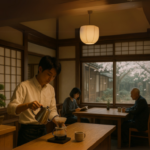








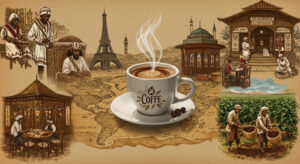

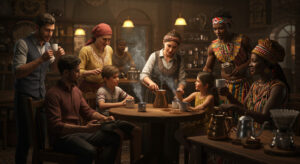



Post Comment